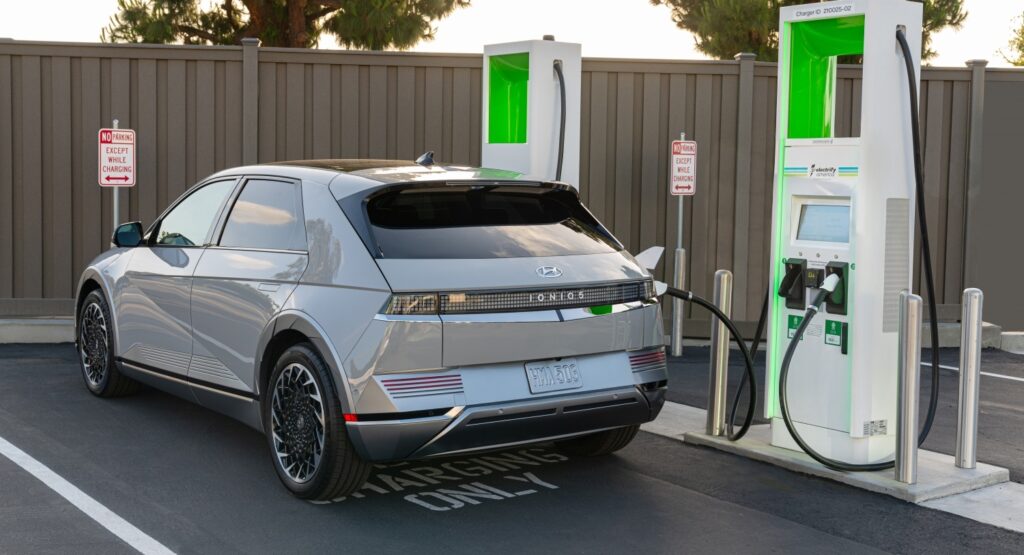
Some may think of electric vehicles as a concept of the future, but over 2 million EVs are already on American roads. By 2030, that figure may exceed 5 million. Where will all of these EVs juice up on road trips? Say hello to the gas station of the future. Charging stations are growing as more automakers commit to electrification.
Among the key players in EV charging is Electrify America. With roots in the 2015 dieselgate debacle, Electrify America is out to show the masses that electric cars are accessible and convenient. Maybe you’ve even seen their glowing green stations in your local Walmart parking lot. Who knows, you might find yourself at an Electrify America station sooner than you think.
Get the most when you sell your car.
Compare and choose multiple offers in minutes:
Let’s cover the basics of Electrify America:
- How much does Electrify America cost?
- What is Electrify America’s pricing?
- Where are Electrify America charging stations?
- And so much more!
Let’s dive in.
What Is Electrify America?
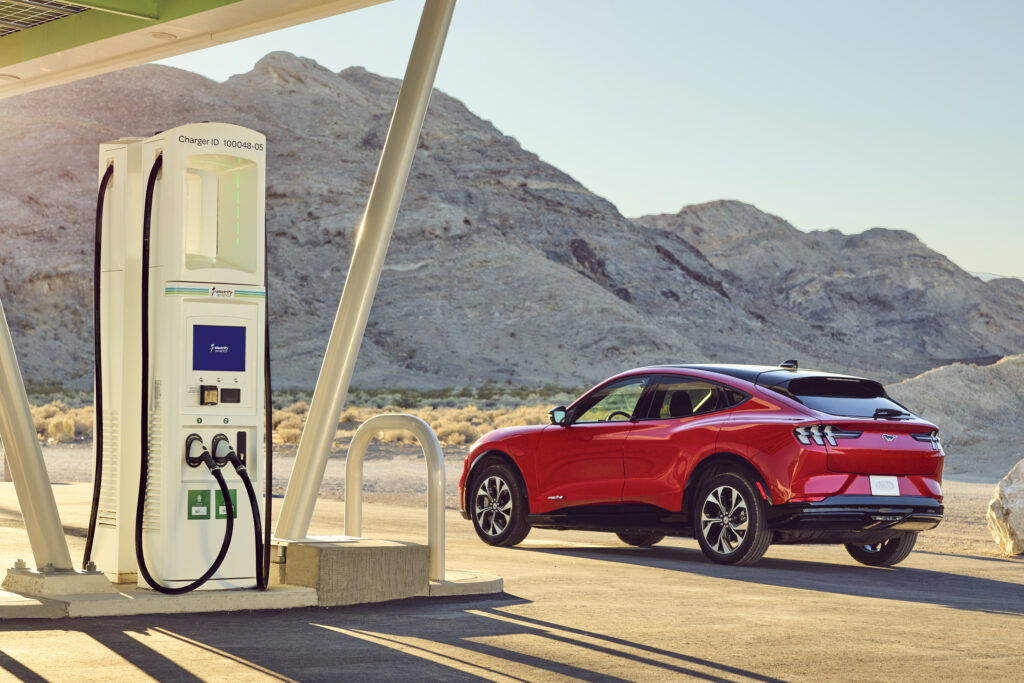
Electrify America is the rebranded name for the initiative that Volkswagen created and funded as part of its 2016 settlement with the United States Environmental protection Agency and the California Air Resources Board. VW was caught red-handed cheating on emissions tests for millions of diesel cars sold in the US. Remember when everyone had to sell back their cool Golf TDI? VW hit rock bottom in 2015. As part of the $2 billion punishment, Volkswagen is prohibited from branding the charging network as a VW enterprise.
So here we have it, Electrify America! Storied past aside, EA is now a large and rapidly growing player in the world of electric vehicles. Despite initial skepticism, EA showed it was serious by following through on their initial goal of adding 2,000 DC fast chargers within a few years. An average of four EA stations were opened every week since the official debut of Electrify America in May of 2018. Now, EA is embarking on the next stage of growth.
Who Can Charge at Electrify America Stations?

Good news! Any electric vehicle model can plug in at Electrify America charging stations. Even Teslas can charge here, despite having their own exclusive Supercharger network. Tesla may have a walled garden for its customers, but EA is open to all. EA stations include several CCS plug types, which work with nearly all EV models. The stations also have a CHAdeMO plug, which only the Nissan Leaf uses as of 2022.
Plug-and-charge is a convenience feature popularized by Tesla, but now spreading among automakers. Considering Electrify America’s Volkswagen roots, you’d think plug-and-charge would be a given for VW electric cars. Not so, at least not yet. However, it looks like automakers are at fault here, not EA. The 2022 Ford Mustang Mach-E already offers plug-and-charge, saving time and hassles for owners. GM says it will soon, but not by the time Cadillac Lyriq deliveries begin this year.
Charging Speeds
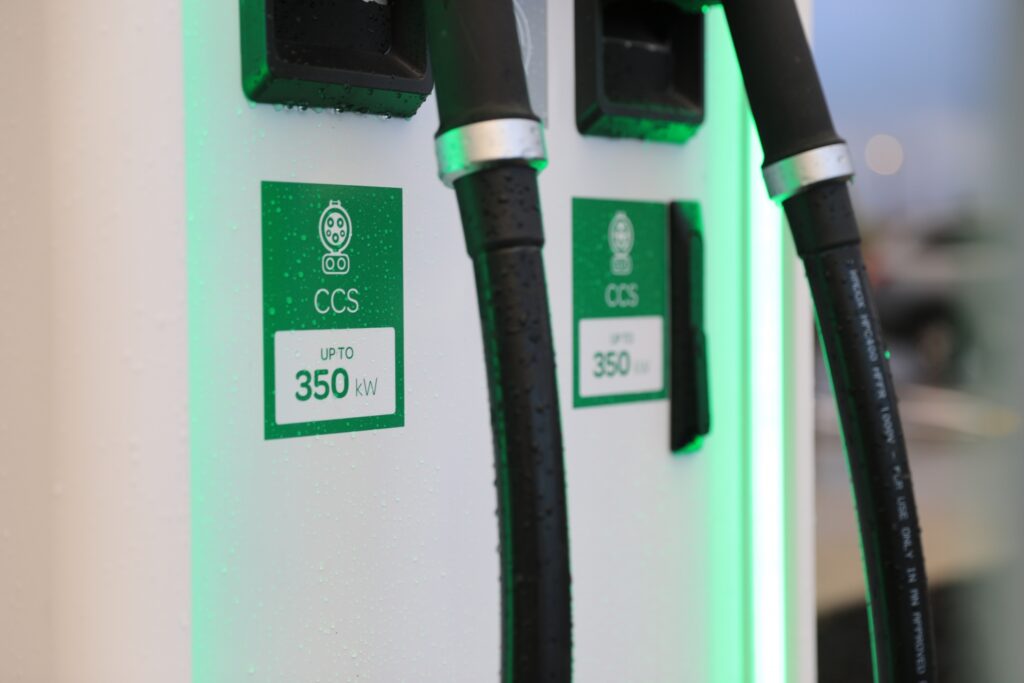
Electrify America charging stations are installed with future-proofing in mind. The vast majority of stations are capable of supplying the latest EVs with up to 350 kW charge speeds. In 2022, only a few EVs are capable of such rapid charging. The Hyundai IONIQ 5, Lucid Air and Porsche Taycan are a few examples. If your EV only accepts slower charging speeds, Electrify America certainly has the power you need to juice up.
How Much Does Charging At Electrify America Cost?
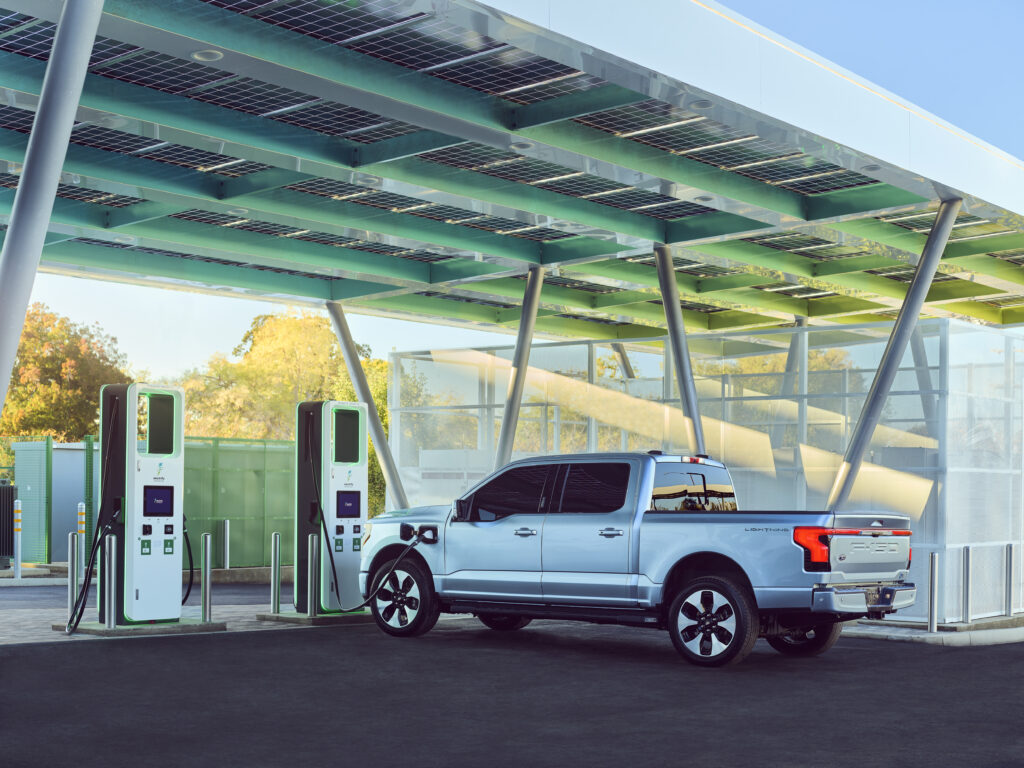
Some lucky EV drivers will have some amount of free charging at Electrify America. The Volkswagen ID.4, Hyundai IONIQ 5, Polestar 2 and even the Lucid Air all come with two or three years of complimentary charging at EA.
Electrify America pricing is determined by the following price tiers. Customers can either pay $0.43 per kilowatt-hour of electricity, or become a Pass+ member for just $4/month and charge up at $0.31 per kWh. For the Ford Mustang Mach-E with the standard battery, a full charge will cost about $21.00 as a Pass+ member, but $30.00 as a guest.
Having such an affordable membership plan is an interesting approach. It almost seems like Electrify America is aiming to become a subscription that everyone with an EV will buy into for a sense of range security, even if they rarely use the network. Learn more about Electrify America pricing and how much it costs to charge an electric vehicle at home or on the road here.
Where Are Electrify America Stations Located?
After an extremely fast build-out, EA now has chargers in 47 states. Only North Dakota, Wyoming and West Virginia have yet to receive EA chargers. Some states have many chargers. Metro areas like Washington DC, Atlanta, New York City, and of course all of California have a high density of EA charging stations.
A large number of EA stations are located in Walmart parking lots. Others are at Target stores, shopping malls, gas stations, and other frequented stops. With the new federal push for a national EV charging network, highway rest areas may soon get their own charging stations.
As of early 2022, Electrify America has 710 charging stations active in the US. Over 100 more are on the way soon. Three-quarters of existing charging ports are of the CCS type. The remainder are CHAdeMO-type plugs, almost exclusively for the Nissan Leaf. The rest of the EV world has moved on from CHAdeMO.
Here are all of the Electrify America charging locations as of early 2022. Future stations are in gray.
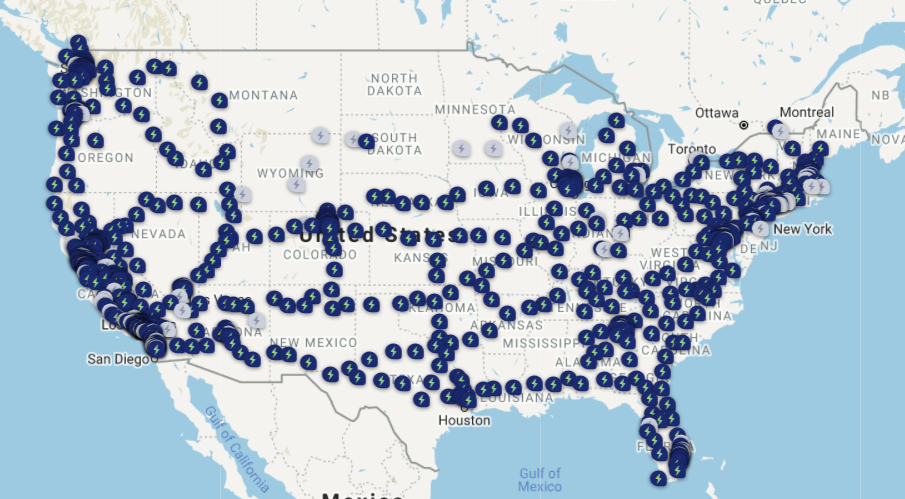
Source: Electrify America
The 2025 Boost Plan: 1,800 Stations and 10,000 Chargers By 2025
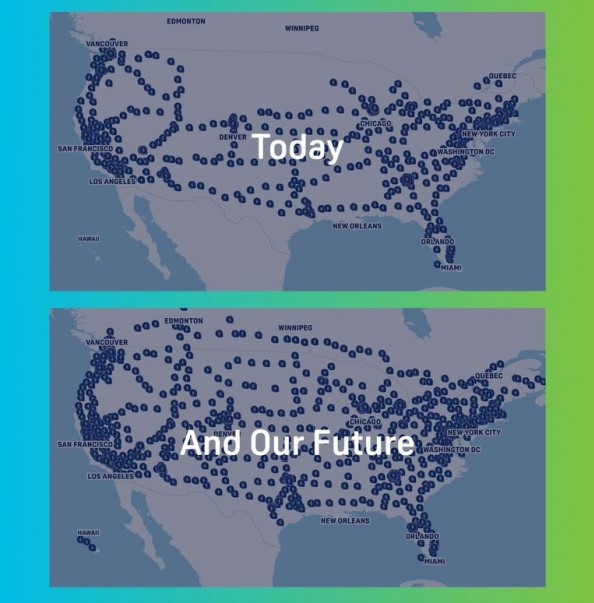
Electrify America’s original goal was to have about 800 charging stations and approximately 3,500 individual chargers in the U.S. by the end of 2021. As you can see above, they clearly exceeded that ambitious goal. Now, EA is looking ahead to their 2025 Boost Plan. The new plan calls for increasing the total number of charging stations to more than 1,700 and 9,500 individual chargers by the end of 2025. Soon, all 50 states will be home to EA charging stations. For me in West Virginia, that can’t come soon enough. It’s a charging desert out here in the hills.
Tesla Superchargers
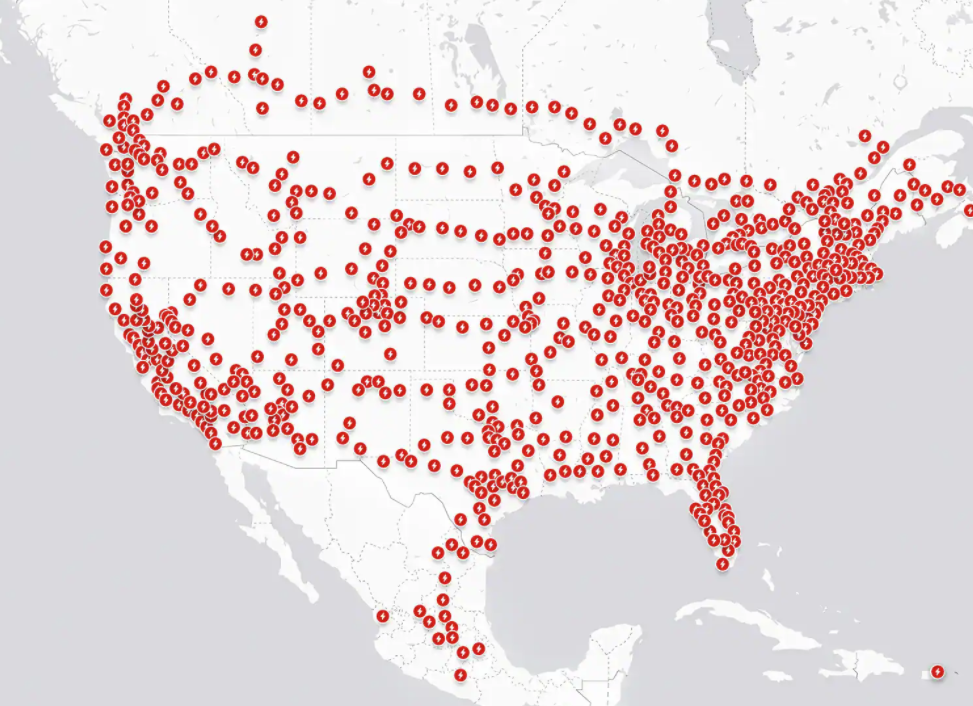
With so much competition arriving in the electric vehicle segment, buyers have far more options than they did just a few years prior. Back in 2018, it was Tesla, the Chevy Bolt and the Nissan Leaf that were selling in big numbers. Now look at the list of every EV on sale in 2022. Consumers have options! And by the time Electrify America’s 2025 Boost Plan is carried out, EV sales are expected to make up at least 12% of total vehicle sales.
Still, Tesla continues to lead electric sales by a large margin. Tesla drivers can charge at Electrify America stations if they bring their own plug adapter. Unfortunately, only Tesla cars can plug in at the sprawling Tesla Supercharger network. Tesla’s proprietary network of exclusive chargers just reached a major milestone. As of late 2021, there are 30,000 charging stalls at over 5,000 locations worldwide. One-sixth of those charging stations were built in the latter half of 2021 alone. In the US, there are nearly 1,000 Supercharger locations, a figure that is rapidly growing.
Tesla also has a level 2 Destination Network at tourist destinations, hotels, restaurants and other destinations. Soon, there will even be a Megacharger Network to support the coming Tesla Semi. Rumors abound that Tesla will open up the Supercharger network to non-Tesla cars, as they have already tried in select European countries. Until that officially happens in the US, Superchargers remain off limits to Ford, GM, Hyundai and every other automaker’s EVs.
Tesla Superchargers are not free. In fact, charging will cost $0.28 per kilowatt-hour of electricity in most markets. Learn more about how much it costs to charge an electric vehicle in our recent report.
How Does Electrify America Compare to Tesla or a Gas Station?
Clearly, electricity is cheaper than gasoline, no matter where you plug in:
| Cost of Charging to 100% at a Tesla Supercharger | Cost of Charging to 100% at Electrify America as a Member | Cost of Charging to 100% at Electrify America as a Guest | Cost of Filling up an 18 Gallon Tank of Gas at $3.25/Gallon |
| $22.96 | $25.42 | $35.26 | $58.50 |
CarEdge’s Take
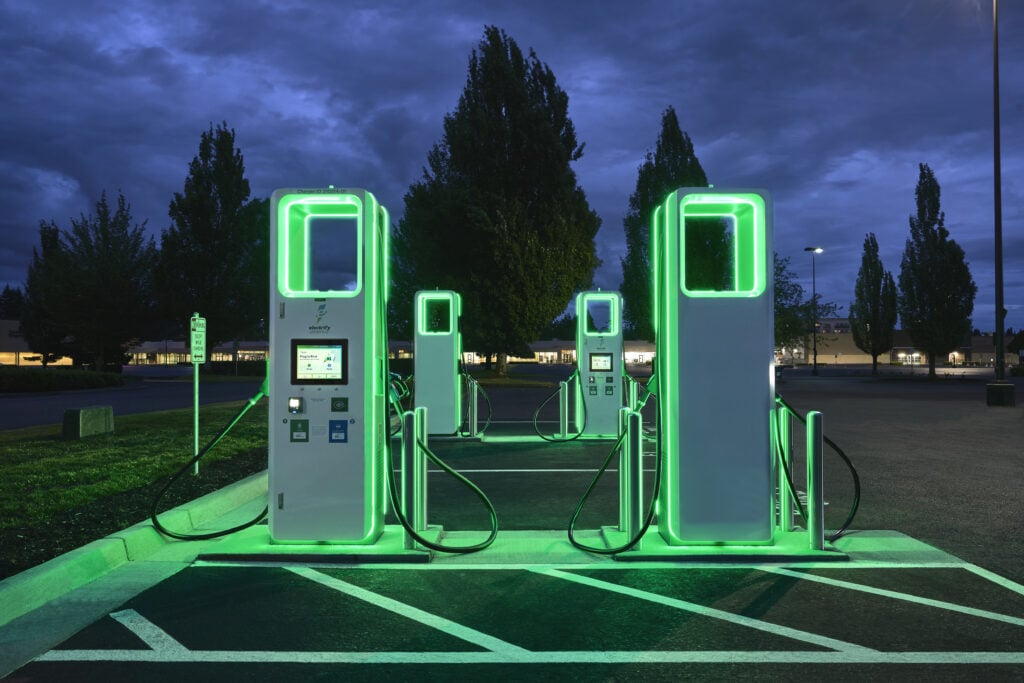
The automotive industry is commiting to EVs. With nearly half a trillion dollars committed to EV development this decade, is this a ‘too big to fail’ moment? However, what good are EVs if there’s nowhere to charge them? Actually, over 80% of electric vehicle charging happens at home. Still, road trips would be dead if automakers electrify without having public fast chargers as widespread as today’s gas stations.
Aside from the Tesla Supercharger network, Electrify America is the best shot we have at rapidly building out a DC fast charging network across America. Automakers, utilities and even the federal government are currently figuring out how to grow charging infrastructure in America. The recent National EV Charging Summit highlighted those efforts, and also the immense challenges ahead. Electrify America’s 2025 Boost Plan offers a glimpse of the electric future to come along American highways.
What do you think? Will Electrify America and the growing Tesla Supercharger network be enough for EVs to comfortably reach the forecasted 30-40% market share in 2030?








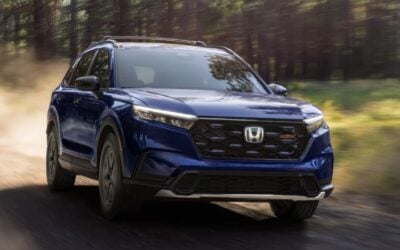

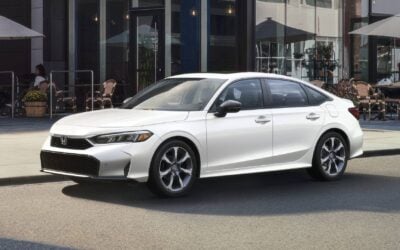


Hi Mr. Fischer! Thank you for the comparison charts, and for publishing the comments from your readers on the other EV articles that you have authored. The information and reader thoughts are valuable in making my decision to buy an EV. Hydrogen power? Please no static electricity!
I think that in the future, if politics is removed from this development and industry, private industry will excel in providing the consumer with self-charging ability. For many years there were telephone booths available for people to make a call for a small fee. As technology developed, the telephone booths have all but disappeared completely. Consumers now carry their portable phones with them. Here’s an idea for an inventor: develop a charger that can be carried to charge your EV and confidentially travel cross-country. Then charge your EV and charger at your destination. No, it’s not a novel idea. There are portable chargers for smart phones and for conventional car batteries. Time and more R&D will provide EV buyers to carry self-charging capabilities in their frunk. Here’s a question: what sources are currently used to power the grid for the charging stations? Wind, Solar, natural gas, coal? At this time, today (2/3/2022), there are over 50,000 consumers without electricity in Texas (https://www.newsweek.com/texas-power-outage-winter-snow-storm-landon-weather-forecast-latest-1675736).
Over reliance on green energy can be disastrous.
While I am moving closer to an EV purchase because of easier maintenance than my combustion engine vehicles, I find it prudent to continue using my cylinder engines for the power and distance that they can provide. I will continue to read your authored articles as I find them encouraging, providing a wealth of EV information in this contentious battle of EV proponents and combustion engine aficionados. In my estimation, the government will draw the line and force the EV on consumers. (Is it already happening?) Just my thoughts.
“Here’s an idea for an inventor: develop a charger that can be carried to charge your EV and confidentially travel cross-country. Then charge your EV and charger at your destination.”
Let’s see, it’s 2800 miles from NY to LA. The average EV (which isn’t towing anything) needs 0.346 kWh to travel one mile; so this “charger that can be carried” would need to be 970kWh to make the trip. A Tesla Model 3 battery weighs 1168 lbs. and contains 75kWh, so the 970kWh “charger that can be carried” would weigh 15,106 lbs.
Now consider that an EV towing 15,000 pounds would need way more than 0.346 kWh to travel one mile; let’s say it’s .7kWh/mile. Now the “charger that can be carried” would need to be about 2000 kWh, or about 30,000 lbs. But towing a 30,000 pound battery would increase consumption further, and so on…
I hope you can see that your idea is completely impractical.